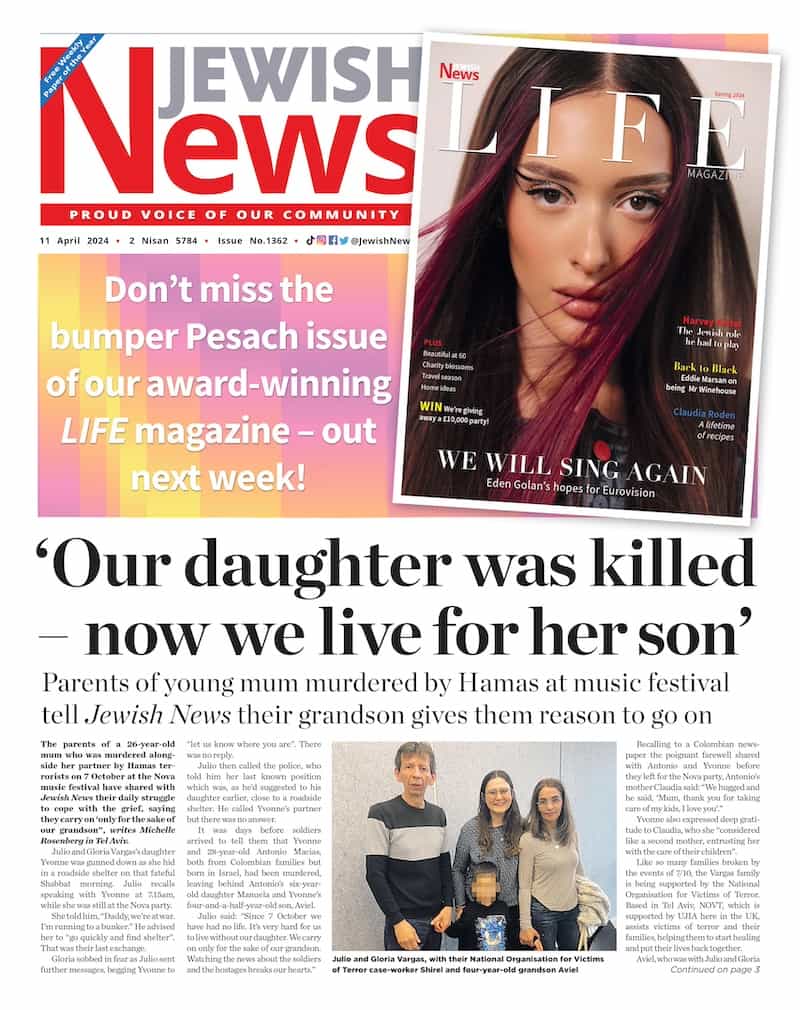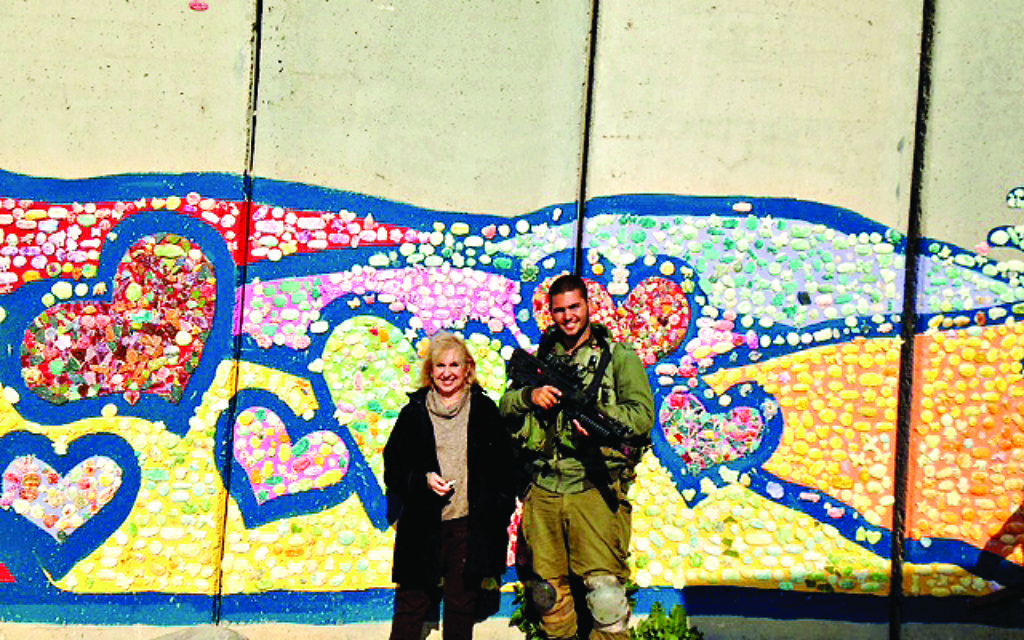OPINION: My 36 anxious hours facing terror on the Gaza border
By Gillian Walnes Perry

LAST MONTH, my husband Elon Perry, a retired journalist with experience of covering and fighting in Israel’s wars, wanted me to experience another type of trip in Israel other than just to visit family.
He wanted me to experience what it is like for Israeli families living on the Gaza border under the constant threat of rockets; to spend 36 hours in the immediate conflict area, including one night at Netiv Ha’Asara, a moshav just 200 metres from Gaza. At first the idea was scary, but then I realised it as a way to see what others have endured. The fact Elon had been a reserve soldier in Gaza for 16 years made me feel more secure.
Get The Jewish News Daily Edition by email and never miss our top stories Free Sign Up
He had made contact with Tsemeret Zamir, a fantastic woman who lives in Netiv Ha’Asara, the closest community to the border. Her home faces the security wall, a constant grey concrete reminder of the hatred just a few metres away from her kitchen. She invited us to stay the night and join her family for dinner, but I was quietly fearful.
A talented ceramicist, Tsemeret has developed her own form of resistance to the constant fear; a project called Pathways to Peace. She encourages visitors to her studio to make small pottery flower and animal shapes, which they then glue on to a huge colourful mosaic on the side of the grey concrete security wall facing towards Gaza [see picture, right, of Gillian and a soldier]. Alongside the mosaic, a large painted dove of peace and the words shalom and saalam confront the Gazans.
To celebrate the last night of Chanukah, the children came out to walk defiantly in procession around the moshav’s perimeter fence. We followed the half-hour journey of the children, some as young as three, as they marched defiantly along the darkened pathway, lit only by the lamps, torches and flares they carried aloft. They then sat by the camp fire to eat and sing songs.
I asked some teenagers how they felt living so close to the hostility and they said they just get on with it and don’t let fear get the better of them.
Tsemeret herself had grown up locally, living as a neighbour with the Gazans and, before the 2014 war, had warm relations with many of her Palestinian neighbours, popping back and forth across the border to shop and see friends.
Although some in her community felt her wall art project was one of idealism, she said Israelis living on the border tended to have more sympathetic feelings towards Gazans than those in the Tel Aviv “bubble”.
She told us children of the moshav (she has four) did suffer from trauma-induced psychological problems, particularly when they saw the rockets coming right over their houses. But because of the moshav’s strong and supportive sense of community, she, her husband and children would not wish to live anywhere else. I had never felt so encouraged by the spirit of young children.
On the way back to dinner, we spoke to a patrol of young IDF soldiers who were guarding the area. As we left the young man who would spend a cold December night in his lookout bunker, my sense of fear heightened. What could he do if any rockets were fired tonight? Scenes from the 2014 Gaza war came back to me and I was anxious.
After dinner, Tsemeret drove us along the border between Gaza and Israel to the neighbouring kibbutz, Yad Mordechai. The lights of the Gazan town of Bet Hanoun, from where most rockets are fired, were visible across the dark Israeli fields.
We heard a fascinating talk on the current situation by well-known journalist Alon Ben-David but I was anxious about sleeping so close to the line of Gazan fire, and it took me a long time to get to sleep. Although Elon slept soundly, I woke up at least three times, thinking about what sound a rocket makes when it is fired and how long it would take to run to one of the shelters (the warning siren allows only 14 seconds).
During the night, a dog barked. I feared an intruder, as Tsemeret had said one of the terrorists’ tunnels was found near their house. The sound of a helicopter circling overhead reminded me that this was a war zone, but gave confidence that someone was looking out from above.
Eventually, morning came. I woke up thankful for a peaceful night and full of admiration for these new Maccabeans living their lives as best they can down on the Gazan border.
• Gillian Walnes Perry, MBE, is co-founder of the Anne Frank Trust. This article is written in a personal capacity

Thank you for helping to make Jewish News the leading source of news and opinion for the UK Jewish community. Today we're asking for your invaluable help to continue putting our community first in everything we do.
For as little as £5 a month you can help sustain the vital work we do in celebrating and standing up for Jewish life in Britain.
Jewish News holds our community together and keeps us connected. Like a synagogue, it’s where people turn to feel part of something bigger. It also proudly shows the rest of Britain the vibrancy and rich culture of modern Jewish life.
You can make a quick and easy one-off or monthly contribution of £5, £10, £20 or any other sum you’re comfortable with.
100% of your donation will help us continue celebrating our community, in all its dynamic diversity...
Engaging
Being a community platform means so much more than producing a newspaper and website. One of our proudest roles is media partnering with our invaluable charities to amplify the outstanding work they do to help us all.
Celebrating
There’s no shortage of oys in the world but Jewish News takes every opportunity to celebrate the joys too, through projects like Night of Heroes, 40 Under 40 and other compelling countdowns that make the community kvell with pride.
Pioneering
In the first collaboration between media outlets from different faiths, Jewish News worked with British Muslim TV and Church Times to produce a list of young activists leading the way on interfaith understanding.
Campaigning
Royal Mail issued a stamp honouring Holocaust hero Sir Nicholas Winton after a Jewish News campaign attracted more than 100,000 backers. Jewish Newsalso produces special editions of the paper highlighting pressing issues including mental health and Holocaust remembrance.
Easy access
In an age when news is readily accessible, Jewish News provides high-quality content free online and offline, removing any financial barriers to connecting people.
Voice of our community to wider society
The Jewish News team regularly appears on TV, radio and on the pages of the national press to comment on stories about the Jewish community. Easy access to the paper on the streets of London also means Jewish News provides an invaluable window into the community for the country at large.
We hope you agree all this is worth preserving.
-
By Laurent Vaughan - Senior Associate (Bishop & Sewell Solicitors)
-
By Laurent Vaughan - Senior Associate (Bishop & Sewell Solicitors)
-
By Laurent Vaughan - Senior Associate (Bishop & Sewell Solicitors)
-
By Laurent Vaughan - Senior Associate (Bishop & Sewell Solicitors)






















